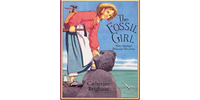Science History: Mary Anning
Fossils and the possibility of finding something prehistoric encased in soil or rock may excite students of all ages (and from an early age!). Whether your student's interest in fossils and paleontology and archaeology stems from a passion for dinosaurs or as an offshoot of fascination with King Tutankhamun, Mary Anning, as a female fossil hunter, is a great person in science history for students to know about. Introduce students to Mary Anning's story—and the world of fossils and paleontology— with books like these, many of which may be available at your school or local library:
Looking for books for older or adult readers? Consider The Fossil Hunter: Dinosaurs, Evolution, and the Woman Whose Discoveries Changed the World (Macmillan Science) (biography) or Tracy Chevalier's New York Times bestseller, Remarkable Creatures: A Novel
(fictionalized account).
Hands-on Fossil Exploration
The new hands-on "Fantastic Fossilization! Discover the Conditions For Creating the Best Cast Fossils" geology project lets students explore "cast" fossils. Cast fossils are one of four types of fossils. As students will discover by doing the science experiment and making their own cast fossils using shells and plaster of Paris, certain types of soil are more suitable for preserving cast fossils than others. In addition to offering an excellent independent science project, this idea can be great for classes or family exploration!
Our "today in Science History" posts make students, teachers, and parents aware of important discoveries and scientists in history and help connect science history to hands-on K-12 science exploration that students (and families) can do today. To follow along, join us at Facebook or at Google+. These frequent science history tidbits can be great for class, dinner, or car-ride discussion!
Categories:
You Might Also Enjoy These Related Posts:
- Book list for science-filled summer reading!
- New Series of Science Buddies Books
- Look Up: Bird and Astronomy Summer Reading
- Blending Science and Art with Paper Inventions
- Special Effects Fun with Nick and Tesla
- Nick and Tesla Build a Gadget Glove: Science Reading
- The Most Magnificent Thing: Science Reading
- Do Even More with Your Raspberry Pi Projects Kit














